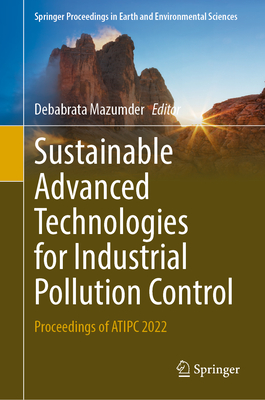图书简介
This proceedings volume constitutes peer-reviewed full-length papers contributed by the Authors and tailored on various thematic areas of the 3rd International Conference on “Advanced Technologies for Industrial Pollution Control” (ATIPC – 2022). The areas of research covered by these papers include but are not limited to: •Water quality monitoring and treatment in industrial area•Industrial effluent treatment, reuse and conservation•Monitoring of industrial emission and control•Industrial solid waste management•Handling and disposal of hazardous waste •Case Studies on industrial pollution control•Innovative technologies in industrial waste management
Chapter 1: Water decontamination through Thiamethoxam removal using DL menthol-octanoic acid Deep Eutectic Solvent : Molecular dynamics insights.- Chapter 2: Methyl Red dye abatement from aqueous solution using Calcium Ferrite and Manganese Ferrite magnetic nanocomposite: Kinetics and isotherm study.- Chapter 3: Adsorption of Fluoride onto PANI-Cl jute fibre - designing higher flow rate and initial concentration column reactor from a batch reactor.- Chapter 4: Biosynthesis of Nano Zero valent Iron (nZVI) using Shorea robusta Leaf Extract and its application in UV-assisted Photocatalytic Degradation of Methyl Orange.- Chapter 5: Method Development for detection of 2-Methylpyridine by High Performance Liquid Chromatography.- Part 2 - Industrial effluent treatment, reuse and conservation.- Chapter 6: Importance of cost functions for biological treatment of wastewater.- Chapter 7: Removal of heavy metals by Laterite soil.- Chapter 8: Removal of Methylene Blue from wastewater by Red Sandy soil-Based Alkali activated binder.- Chapter 9: Assessment and Treatment of iron from industrial wastewater using activated carbon derived from Parkia Speciosa pod.- Chapter 10: Activated Carbon developed from Phumdi biomass and Deccan Hemp for adsorption of Methylene Blue.- Chapter 11: An experimental study of Metanil Yellow dye remediation using Fe-Mn Bimetal oxide composites.- Chapter 12: Optimization of electrocoagulation process parameters using magnesium electrodes for treating pharmaceutical wastewater containing salicylic acid.- Chapter 13: Optimization of process parameters for biodegradation of Cresol by mixed bacterial culture using Response Surface Methodology.- Chapter 14: Biological degradation of Cresol containing wastewater using mixed microbial culture in presence of heavy metals.- Part 3 - Monitoring of industrial emission and control.- Chapter 15: Development of a simplistic model for the prediction of reactive air pollutants in the atmosphere.- Chapter 16: Controlling Air and Metal pollution in industrial area Singrauli, India: Role of plants.- Part 4 - Industrial solid waste management.- Chapter 17: Enhancing the dewatering ability of sludge by locally available biomass.- Chapter 18: Production of Xylose from Water Hyacinth Biomass (WHB) (lignocellulosic waste) for Xylitol production: waste to wealth.- Chapter 19: A simplistic mathematical model for two-stage Anaerobic Digestion of plastic wastes.- Part 5 - Handling and disposal of hazardous waste.- Chapter 20: Modeling migration of Cr(VI) contaminant through Clay Liner using Hydrus-3d.- Chapter 21: Electrokinetic remediation of total Chromium from contaminated soil.- Chapter 22: Low-Cost recovery of Cadmium from wastewater by soil bacteria.- Part 6 - Case Studies on industrial pollution control.- Chapter 23: Tannery waste management in India: A case study.- Chapter 24: Removal of natural organics and selected antibiotics using PAC and AL electrode: A study for Jumar River.- Chapter 25: Quantification of floating plastics using UAV images and Identification of Microplastics in Ukkadam tank.- Chapter 26: Study of wastewater treatment in Hindustan Coca-Cola plant at Khurda.- Part 7 - Innovative technologies in industrial waste management.- Chapter 27: In Vitro Performance Analysis of Ti and Zn doped Hydroxyapatite made from waste Eggshells.- Chapter 28: Production of non-toxic, non-polluting herbal soaps using plant extracts having anti-microbial activity.- Chapter 29: Decolourization of Textile Dye RR 141 using electrochemical process.
Trade Policy 买家须知
- 关于产品:
- ● 正版保障:本网站隶属于中国国际图书贸易集团公司,确保所有图书都是100%正版。
- ● 环保纸张:进口图书大多使用的都是环保轻型张,颜色偏黄,重量比较轻。
- ● 毛边版:即书翻页的地方,故意做成了参差不齐的样子,一般为精装版,更具收藏价值。
关于退换货:- 由于预订产品的特殊性,采购订单正式发订后,买方不得无故取消全部或部分产品的订购。
- 由于进口图书的特殊性,发生以下情况的,请直接拒收货物,由快递返回:
- ● 外包装破损/发错货/少发货/图书外观破损/图书配件不全(例如:光盘等)
并请在工作日通过电话400-008-1110联系我们。
- 签收后,如发生以下情况,请在签收后的5个工作日内联系客服办理退换货:
- ● 缺页/错页/错印/脱线
关于发货时间:- 一般情况下:
- ●【现货】 下单后48小时内由北京(库房)发出快递。
- ●【预订】【预售】下单后国外发货,到货时间预计5-8周左右,店铺默认中通快递,如需顺丰快递邮费到付。
- ● 需要开具发票的客户,发货时间可能在上述基础上再延后1-2个工作日(紧急发票需求,请联系010-68433105/3213);
- ● 如遇其他特殊原因,对发货时间有影响的,我们会第一时间在网站公告,敬请留意。
关于到货时间:- 由于进口图书入境入库后,都是委托第三方快递发货,所以我们只能保证在规定时间内发出,但无法为您保证确切的到货时间。
- ● 主要城市一般2-4天
- ● 偏远地区一般4-7天
关于接听咨询电话的时间:- 010-68433105/3213正常接听咨询电话的时间为:周一至周五上午8:30~下午5:00,周六、日及法定节假日休息,将无法接听来电,敬请谅解。
- 其它时间您也可以通过邮件联系我们:customer@readgo.cn,工作日会优先处理。
关于快递:- ● 已付款订单:主要由中通、宅急送负责派送,订单进度查询请拨打010-68433105/3213。
本书暂无推荐
本书暂无推荐















